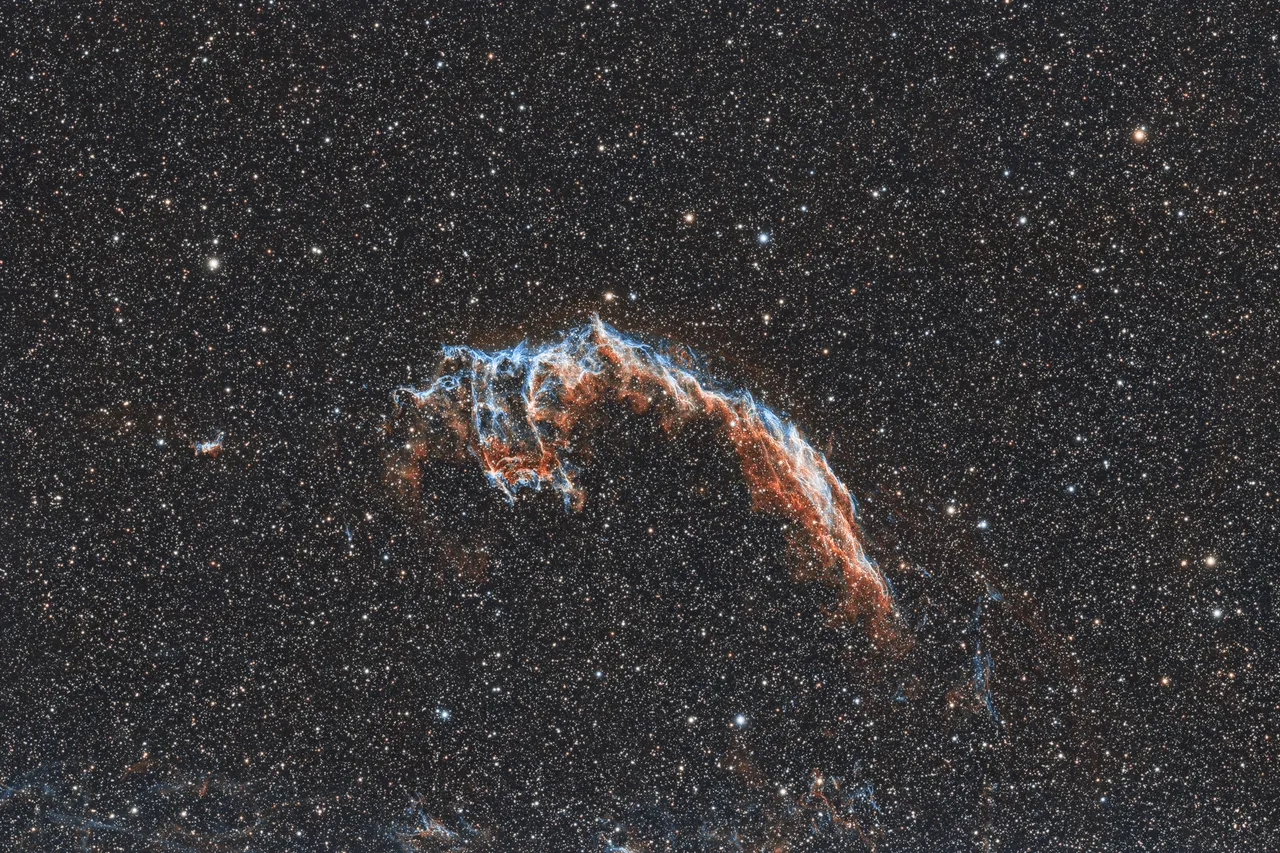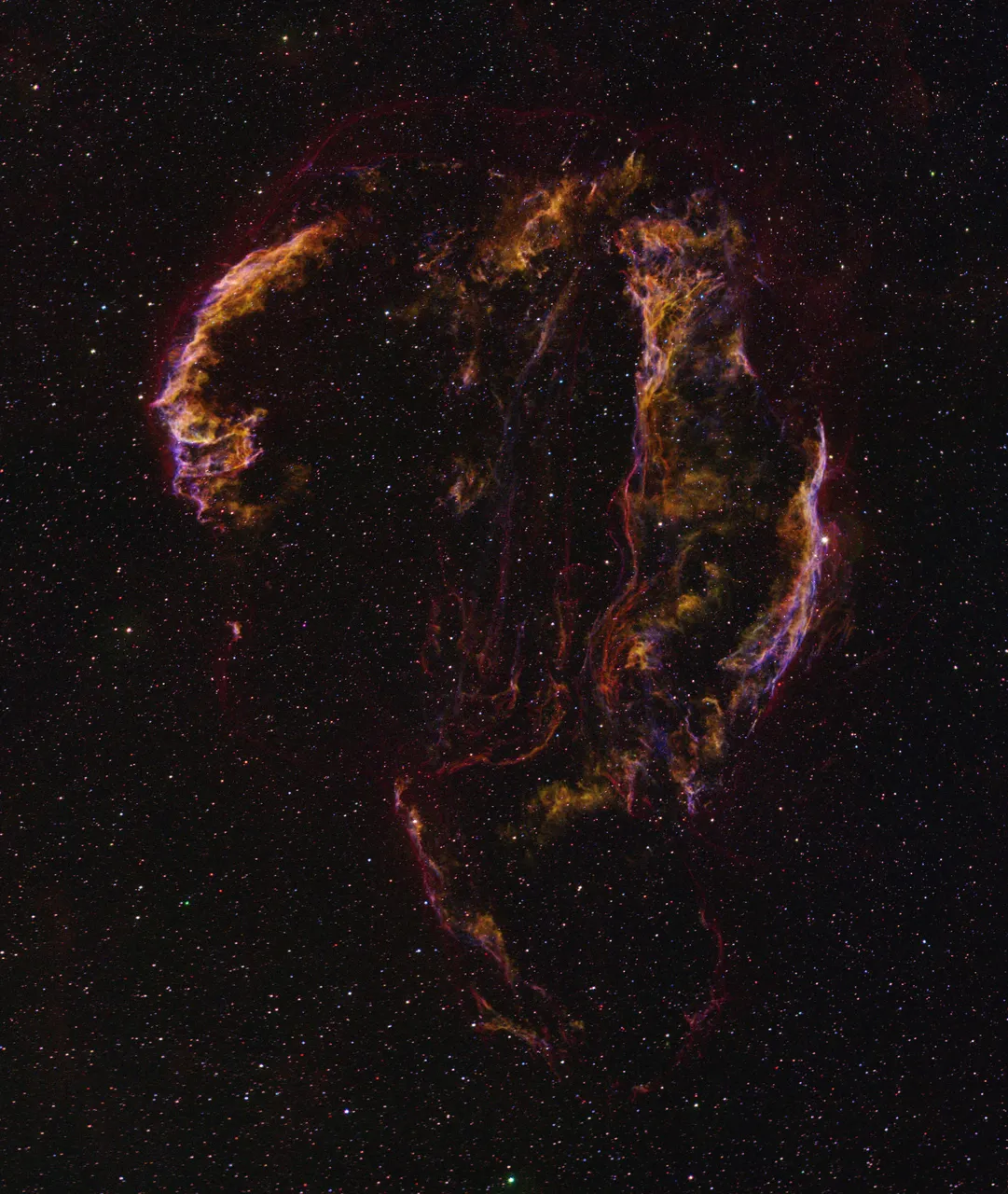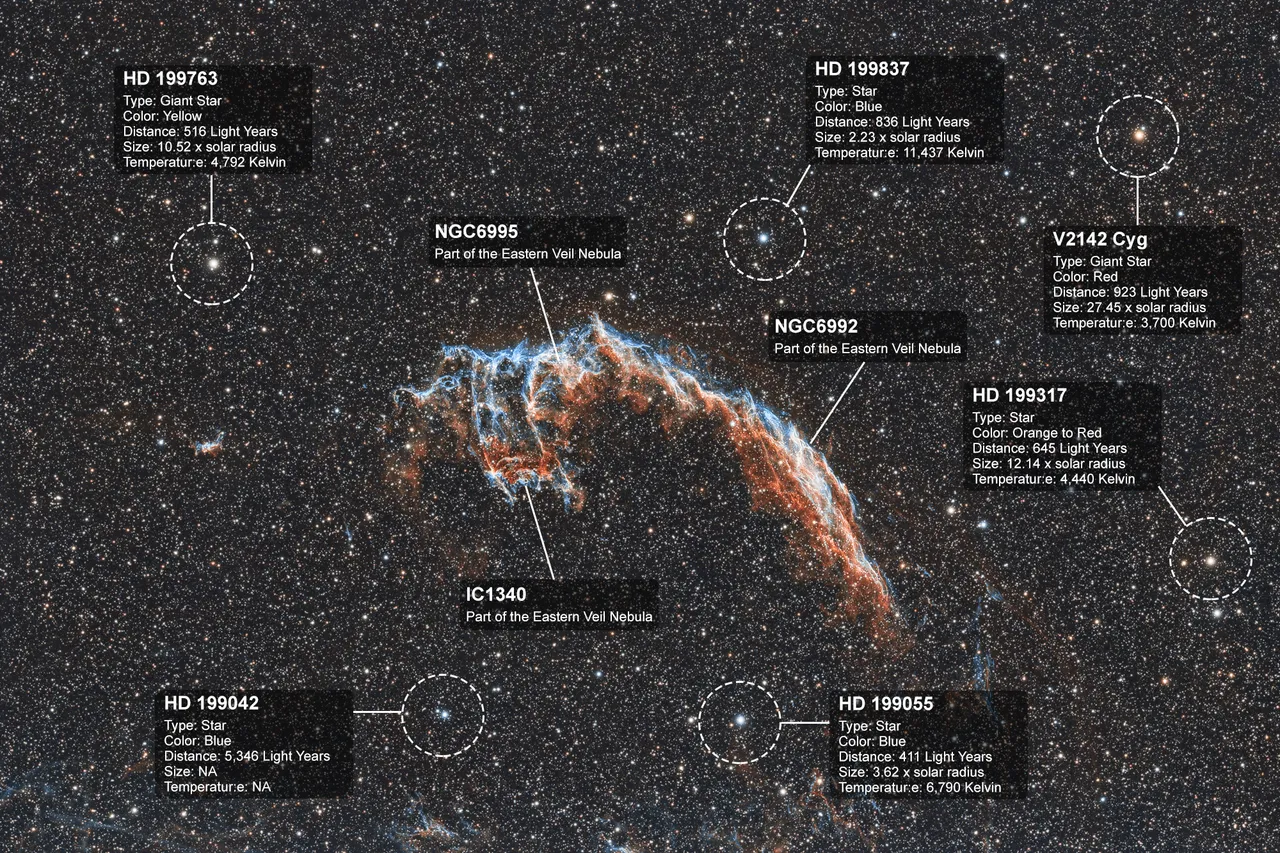The Eastern Veil Nebula (NGC6992, NGC6995 and IC1340) is a part of the big supernova remnant which is called the Veil Nebula and is located in the constellation of Cygnus, around 1470 light-years away from us. It envolved due to a supernova explosion that happened about 8000 years ago. The whole cloud of ionized gas (mostly hydrogen, oxygen, and sulfur) extends, as seen from Earth, over an area 6 times the diameter of the full moon. You will find an image of the whole complex a little further on this post. The Eastern Veil Nebula is just a smaller and one of the outer parts in this huge construct.
The Eastern Veil Nebula at a focal length of 420mm.

Click on the picture for a larger view ▲
The red parts in this image are showing the ionized hydrogen gas while the blue ones are showing the ionized oxygen. The green channel is made out of the blue channel, which should give a more natural look than just using two colors.
Because the Eastern Veil Nebula is also a located in the constellation Cygnus, which is crossed by the band of the Milky Way, the star density is very high in this region. Like on the
North America Nebula, these stars are hiding a lot of details in the faint areas of the nebula and the background.
My attempt to reduce the stars so that the faint nebula can be better recognized.

Click on the picture for a larger view ▲
For the star removal process, I tried Starnet++ this time, which is open-source software that uses a neural network to calculate out the stars. It's way more comfortable than my previous star removal workflow, but even with 11 hours of total exposure time, it produces some artifacts were the stars where before. Sadly, I also lost some details in the bright areas of the nebula itself.
Anyway, the faint nebulas and dust in the background can be seen much better without the stars.
The whole Veil Nebula complex. Image made by Mikael Svalgaard.
 Author: Mikael Svalgaard, http://www.leif.org/mikael
Author: Mikael Svalgaard, http://www.leif.org/mikael
Position in the night sky
Like the North America Nebula, which I made a post about here and as mentioned before, the Eastern Veil Nebula belongs is also a part of the constellation Cygnus. It is located in between the stars Epsilon Cygni (Gienah in the image) and Zeta Cygni. You can also see the North America Nebula in the middle/upper left part near the star Deneb.
Position of the Eastern Veil Nebula in the night sky. Screenshot of SkySafari Plus app for iOS.

Click on the picture for a larger view ▲
What else is on the image
In the following picture, I have marked some more or less bright stars. As mentioned above, these are the three parts (NGC6992, NGC6995 and IC1430), which all 3 belongs to the Eastern Veil Nebula.
I used the Aladin Sky Atlas suite to identify the stars in the image for the first time. It is a free sky atlas which contains quite good databases.
Image with names of some objects/stars. Created by hand in Photoshop.

Click on the picture for a larger view ▲
Details of the image
The picture was taken in my Backyard with the following equipment and settings.
| Camera |
QHYCCD247C |
| Telescope |
TSAPO65Q · 420mm · f6.5 |
| Filter |
STC Duo-Narrowband Filter (48mm / 2") |
| Guide camera |
QHY5L-II |
| Guide scope |
TSL60D · 240mm · f4.0 |
| Mount |
Skywatcher AZ EQ-6 |
| Exposure time |
132 x 300" = 660 minutes = 11 hours |
| ISO |
Unity Gain @ -20°C |
Everything is controlled by my Astro-PC via remote desktop and wireless LAN.
Software: Sequence Generator Pro, PixInsight, Photoshop CC
I posted a single shot from my first imaging session here if you want to see the difference between the final stacked image and a single exposure of 5 minutes.
The license of my pictures
All images, otherwise clearly indicated, in this post are my own work.
You can use it for free if you credit them to @astrophoto.kevin.
 Attribution-ShareAlike 4.0 International (CC BY-SA 4.0)
Attribution-ShareAlike 4.0 International (CC BY-SA 4.0)
References
https://aladin.u-strasbg.fr/AladinDesktop/
https://www.universeguide.com/star/v2142cygni
https://www.universeguide.com/star/hip103510
https://www.universeguide.com/star/hip103116
https://www.universeguide.com/star/hip103278
https://www.universeguide.com/star/hip103548
https://www.universeguide.com/star/hip103115
https://en.wikipedia.org/wiki/Veil_Nebula
https://www.constellation-guide.com/veil-nebula/
Thank you very much for visiting and reading!
If you have any questions or suggestions, please don’t be afraid to let me know of anything you thought about this post in the comments below!
Yours, @astrophoto.kevin

SteemSTEM is a community project with the goal to promote and support Science, Technology, Engineering and Mathematics on the Steem blockchain. If you wish to support the steemSTEM project you can:
Contribute STEM content using the #steemstem tag | Support steemstem authors | Join our curation trail | Visit our Discord community | Delegate SP to steemstem
Convenient Delegation Links:
50 SP | 100SP | 500SP | 1,000SP | 5,000SP | 10,000SP | 50,000SP
The Eastern Veil Nebula (NGC6992, NGC6995 and IC1340) is a part of the big supernova remnant which is called the Veil Nebula and is located in the constellation of Cygnus, around 1470 light-years away from us. It envolved due to a supernova explosion that happened about 8000 years ago. The whole cloud of ionized gas (mostly hydrogen, oxygen, and sulfur) extends, as seen from Earth, over an area 6 times the diameter of the full moon. You will find an image of the whole complex a little further on this post. The Eastern Veil Nebula is just a smaller and one of the outer parts in this huge construct.
The Eastern Veil Nebula at a focal length of 420mm.
Click on the picture for a larger view ▲
The red parts in this image are showing the ionized hydrogen gas while the blue ones are showing the ionized oxygen. The green channel is made out of the blue channel, which should give a more natural look than just using two colors.
Because the Eastern Veil Nebula is also a located in the constellation Cygnus, which is crossed by the band of the Milky Way, the star density is very high in this region. Like on the North America Nebula, these stars are hiding a lot of details in the faint areas of the nebula and the background.
My attempt to reduce the stars so that the faint nebula can be better recognized.
Click on the picture for a larger view ▲
For the star removal process, I tried Starnet++ this time, which is open-source software that uses a neural network to calculate out the stars. It's way more comfortable than my previous star removal workflow, but even with 11 hours of total exposure time, it produces some artifacts were the stars where before. Sadly, I also lost some details in the bright areas of the nebula itself.
Anyway, the faint nebulas and dust in the background can be seen much better without the stars.
The whole Veil Nebula complex. Image made by Mikael Svalgaard.
Author: Mikael Svalgaard, http://www.leif.org/mikael
Position in the night sky
Like the North America Nebula, which I made a post about here and as mentioned before, the Eastern Veil Nebula belongs is also a part of the constellation Cygnus. It is located in between the stars Epsilon Cygni (Gienah in the image) and Zeta Cygni. You can also see the North America Nebula in the middle/upper left part near the star Deneb.
Position of the Eastern Veil Nebula in the night sky. Screenshot of SkySafari Plus app for iOS.
Click on the picture for a larger view ▲
What else is on the image
In the following picture, I have marked some more or less bright stars. As mentioned above, these are the three parts (NGC6992, NGC6995 and IC1430), which all 3 belongs to the Eastern Veil Nebula. I used the Aladin Sky Atlas suite to identify the stars in the image for the first time. It is a free sky atlas which contains quite good databases.
Image with names of some objects/stars. Created by hand in Photoshop.
Click on the picture for a larger view ▲
Details of the image
The picture was taken in my Backyard with the following equipment and settings.
Everything is controlled by my Astro-PC via remote desktop and wireless LAN.
Software: Sequence Generator Pro, PixInsight, Photoshop CC
I posted a single shot from my first imaging session here if you want to see the difference between the final stacked image and a single exposure of 5 minutes.
The license of my pictures
All images, otherwise clearly indicated, in this post are my own work.
You can use it for free if you credit them to @astrophoto.kevin.
References
https://aladin.u-strasbg.fr/AladinDesktop/
https://www.universeguide.com/star/v2142cygni
https://www.universeguide.com/star/hip103510
https://www.universeguide.com/star/hip103116
https://www.universeguide.com/star/hip103278
https://www.universeguide.com/star/hip103548
https://www.universeguide.com/star/hip103115
https://en.wikipedia.org/wiki/Veil_Nebula
https://www.constellation-guide.com/veil-nebula/
Thank you very much for visiting and reading!
If you have any questions or suggestions, please don’t be afraid to let me know of anything you thought about this post in the comments below!
Yours, @astrophoto.kevin
SteemSTEM is a community project with the goal to promote and support Science, Technology, Engineering and Mathematics on the Steem blockchain. If you wish to support the steemSTEM project you can:
Contribute STEM content using the #steemstem tag | Support steemstem authors | Join our curation trail | Visit our Discord community | Delegate SP to steemstem